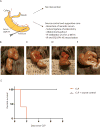Collapse of the Microbiome, Emergence of the Pathobiome, and the Immunopathology of Sepsis
- PMID: 28098630
- PMCID: PMC5245179
- DOI: 10.1097/CCM.0000000000002172
Collapse of the Microbiome, Emergence of the Pathobiome, and the Immunopathology of Sepsis
Abstract
The definition of sepsis has been recently modified to accommodate emerging knowledge in the field, while at the same time being recognized as challenging, if not impossible, to define. Here, we seek to clarify the current understanding of sepsis as one that has been typically framed as a disorder of inflammation to one in which the competing interests of the microbiota, pathobiota, and host immune cells lead to loss of resilience and nonresolving organ dysfunction. Here, we challenge the existence of the idea of noninfectious sepsis given that critically ill humans never exist in a germ-free state. Finally, we propose a new vision of the pathophysiology of sepsis that includes the invariable loss of the host's microbiome with the emergence of a pathobiome consisting of both "healthcare-acquired and healthcare-adapted pathobiota." Under this framework, the critically ill patient is viewed as a host colonized by pathobiota dynamically expressing emergent properties which drive, and are driven by, a pathoadaptive immune response.
Figures

References
-
- The Ascent of Man - BBC Four [Internet] BBC. [cited 2016 Oct 5] Available from: http://www.bbc.co.uk/programmes/b00wms4m.
-
- Shankar-Hari M, Deutschman CS, Singer M. Do we need a new definition of sepsis? Intensive Care Med. 2015;41:909–911. - PubMed
-
- Vincent J-L, Rello J, Marshall J, et al. International study of the prevalence and outcomes of infection in intensive care units. JAMA. 2009;302:2323–2329. - PubMed
MeSH terms
Grants and funding
LinkOut - more resources
Full Text Sources
Other Literature Sources
Medical

